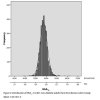So why does the NHS NICE website rrcommend 48 as the target value?
My GP tells me that is the preferred value for type 2 patients, whereas the 20-41 range is for non-diabetic patients. Is that right?

This histogram from University of Groningen (2011) may help to explain why the international consensus of diabetes experts decided on 48 mm/mol. It also indicates why 35-41 mm/mol is a good target range for those who can do better (mean 38+/-3).
See: https://pure.rug.nl/ws/portalfiles/portal/14502679/01c1.pdf
